hPCL3S promotes proliferation and migration of androgen-independent prostate cancer cells
- PMID: 32256978
- PMCID: PMC7105160
- DOI: 10.18632/oncotarget.27511
hPCL3S promotes proliferation and migration of androgen-independent prostate cancer cells
Abstract
Polycomb repressive complex 2 (PRC2) allows the deposition of H3K27me3. PRC2 facultative subunits modulate its activity and recruitment such as hPCL3/PHF19, a human ortholog of Drosophila Polycomb-like protein (PCL). These proteins contain a TUDOR domain binding H3K36me3, two PHD domains and a "Winged-helix" domain involved in GC-rich DNA binding. The human PCL3 locus encodes the full-length hPCL3L protein and a shorter isoform, hPCL3S containing the TUDOR and PHD1 domains only. In this study, we demonstrated by RT-qPCR analyses of 25 prostate tumors that hPCL3S is frequently up-regulated. In addition, hPCL3S is overexpressed in the androgen-independent DU145 and PC3 cells, but not in the androgen-dependent LNCaP cells. hPCL3S knockdown decreased the proliferation and migration of DU145 and PC3 whereas its forced expression into LNCaP increased these properties. A mutant hPCL3S unable to bind H3K36me3 (TUDOR-W50A) increased proliferation and migration of LNCaP similarly to wt hPCL3S whereas inactivation of its PHD1 domain decreased proliferation. These effects partially relied on the up-regulation of genes known to be important for the proliferation and/or migration of prostate cancer cells such as S100A16, PlexinA2, and Spondin1. Collectively, our results suggest hPCL3S as a new potential therapeutic target in castration resistant prostate cancers.
Keywords: PHF19; PRC2; hPCL3S; prostate cancer; β-catenin.
Conflict of interest statement
CONFLICTS OF INTEREST The authors declare no disclosure of potential conflicts of interest.
Figures

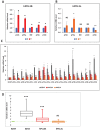
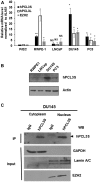

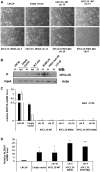



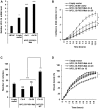

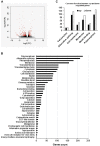

Similar articles
-
Regulation of hPCL3 isoforms' ubiquitination by TRIM21 in non-small cell lung cancer progression.Life Sci Alliance. 2023 Jul 28;6(10):e202302060. doi: 10.26508/lsa.202302060. Print 2023 Oct. Life Sci Alliance. 2023. PMID: 37507137 Free PMC article.
-
Functional characterization of human Polycomb-like 3 isoforms identifies them as components of distinct EZH2 protein complexes.Biochem J. 2011 Mar 1;434(2):333-42. doi: 10.1042/BJ20100944. Biochem J. 2011. PMID: 21143197
-
hPCL3s Promotes Hepatocellular Carcinoma Metastasis by Activating β-Catenin Signaling.Cancer Res. 2018 May 15;78(10):2536-2549. doi: 10.1158/0008-5472.CAN-17-0028. Epub 2018 Feb 26. Cancer Res. 2018. PMID: 29483096
-
Tudor domains of the PRC2 components PHF1 and PHF19 selectively bind to histone H3K36me3.Biochem Biophys Res Commun. 2013 Jan 11;430(2):547-53. doi: 10.1016/j.bbrc.2012.11.116. Epub 2012 Dec 7. Biochem Biophys Res Commun. 2013. PMID: 23228662
-
PHF19 mediated regulation of proliferation and invasiveness in prostate cancer cells.Elife. 2020 Mar 10;9:e51373. doi: 10.7554/eLife.51373. Elife. 2020. PMID: 32155117 Free PMC article.
Cited by
-
Regulation of hPCL3 isoforms' ubiquitination by TRIM21 in non-small cell lung cancer progression.Life Sci Alliance. 2023 Jul 28;6(10):e202302060. doi: 10.26508/lsa.202302060. Print 2023 Oct. Life Sci Alliance. 2023. PMID: 37507137 Free PMC article.
-
HIC1 (Hypermethylated in Cancer 1) modulates the contractile activity of prostate stromal fibroblasts and directly regulates CXCL12 expression.Oncotarget. 2020 Nov 10;11(45):4138-4154. doi: 10.18632/oncotarget.27786. eCollection 2020 Nov 10. Oncotarget. 2020. PMID: 33227080 Free PMC article.
-
Insights into high-risk multiple myeloma from an analysis of the role of PHF19 in cancer.J Exp Clin Cancer Res. 2021 Dec 2;40(1):380. doi: 10.1186/s13046-021-02185-1. J Exp Clin Cancer Res. 2021. PMID: 34857028 Free PMC article. Review.
-
Epigenetic (De)regulation in Prostate Cancer.Cancer Treat Res. 2023;190:321-360. doi: 10.1007/978-3-031-45654-1_10. Cancer Treat Res. 2023. PMID: 38113006 Free PMC article.
-
Polycomb-like Proteins in Gene Regulation and Cancer.Genes (Basel). 2023 Apr 18;14(4):938. doi: 10.3390/genes14040938. Genes (Basel). 2023. PMID: 37107696 Free PMC article. Review.
References
LinkOut - more resources
Full Text Sources
Miscellaneous

